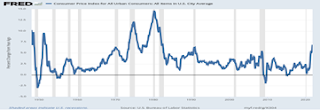Why the feverish speculation that higher inflation could last beyond next year, and dampen economic growth, when the American economy should otherwise return to a semblance of normalcy? The COVID-induced recession of 2020 lasted just two months and caused one of the deepest economic contractions in history.
The recovery is also one of the fastest in history, so it is causing a temporary climb in inflation. Firstly, consumers and businesses are flush with cash for the holidays. Why wouldn’t they want to spend it now, regardless of the rising prices sure to follow? Expectations are usually high during the holidays.
In May 2020 the CPI, seasonally adjusted inflation rate for consumers was a mere 00.22 percent and in November 2021 had risen to 6.9 percent, seasonally adjusted. But there is usually a New Year drop off in spending because consumers want to pay down their credit bills and save for the April tax season. So prices should also subside substantially, as most retail businesses know after the holiday shopping splurge.
There are a few caveats to this forecast, however. The Biden administration is not helping to lower inflation by reducing the Trump trade tariffs. Raising tariffs made more sense when the economy was booming before the pandemic, and we wanted to repatriate U.S. businesses to our homeland to boost American jobs.
But if the supply-chain slowdown is to be improved, smart economic policy says that tariffs should be lowered to increase the flow of international trade, and ease the supply bottlenecks.
Also, Biden’s ‘Buy America”, and “Made in the USA” emphasis will certainly keep prices from falling faster with products made in the USA, as it’s more expensive to produce things in America, vs. overseas.
But is that a reason for markets to panic, so that the Federal Reserve may overreact by raising interest rates too soon next year? I don’t think so.
Economists such as Larry Summers worry about what is called “stagflation”, a holdover from the 1970s fast rising prices for oil and other commodities that caused unions to follow suit and the Federal Reserve to maintain policies (such as keeping interest rates low) that tolerated higher wages and salaries.
That’s not the case anymore, mainly because unions are much weaker so that wage and salary increases have been kept down, which is a large part of any inflationary spiral.
So the other causes of higher inflation—supply-chain bottlenecks and a shortage of workers—could still be problems.
Nobel Laureate Paul Krugman cites Biden’s Council of Economic Advisors in a recent NY Times Op-ed who believe that this bout of higher inflation most resembles that of 1946-48, when the American economy hadn’t yet geared up to meet soaring consumer demand when also flush with cash from WWII savings.
But there won’t be such a wholesale conversion from a wartime to a peacetime economy in the pandemic recovery. In fact, we will be fast forwarding to an enhanced digital economy with much more reliance on 5G networks and Artificial Intelligence, and less dependence on workers to produce things.
As if to presage such a future the Conference Board’s latest Index of Leading Economic Indicators predicts good growth ahead, with or without the availability of more workers.
“The Conference Board Leading Economic Index® (LEI) for the U.S. increased by 1.1 percent in November to 119.9 (2016 = 100), following a 0.9 percent increase in October and a 0.3 percent increase in September,” stated its latest press release.
“The U.S. LEI rose sharply again in November, suggesting the current economic expansion will continue into the first half of 2022,” said Ataman Ozyildirim, Senior Director of Economic Research at The Conference Board. “Inflation and continuing supply chain disruptions, as well as a resurgence of COVID-19, pose risks to GDP growth in 2022. Still, the economic impact of these risks may be contained. The Conference Board forecasts real GDP growth to strengthen in Q4 2021 to about 6.5 percent (annualized rate), before moderating to a still healthy rate of 2.2 percent in Q1 2022.”
This prediction of a huge jump in future growth is based on 12 hard data indicators such as stock prices, interest rate spreads, and consumer credit flows, which lends more credence to its prediction of future trends—and to the fact that supply-chain disruptions and future employment trends may not be major factors affecting inflation next year.
So worrying about some kind of long-lasting inflationary spiral doesn’t make sense to me
Harlan Green © 2021
Follow Harlan Green on Twitter: https://twitter.com/HarlanGreen


No comments:
Post a Comment